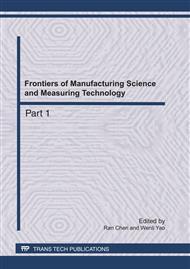p.424
p.429
p.435
p.440
p.444
p.448
p.453
p.457
p.461
Application of Accuracy Engraving Technique in the Motorcycle New Product Development
Abstract:
The relative merits of accuracy engraving technique and rapid prototyping technique during processing are discussed. Because the product dimensions are small and the strength of the rapid prototyping sample workpiece in vertical direction is too small to meet the engineering design requirements, the method using accuracy engraving machine to replace rapid prototyping machine to design product with large size and need to assemble like motorcycle cover is proposed. If the product size is too large, it can be split and every part is carved with the accuracy engraving machine, and then they are sticked together to finish the whole part. So the speed of new product development is accelerated, the cost of new product development is decreased, the rapid manufacturing is realized and the traditional design method using only RP machine is improved. This method has been applied to the development for a new motorcycle cover and the application method is expounded.
Info:
Periodical:
Pages:
444-447
Citation:
Online since:
May 2011
Authors:
Price:
Сopyright:
© 2011 Trans Tech Publications Ltd. All Rights Reserved
Share:
Citation:


